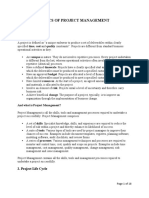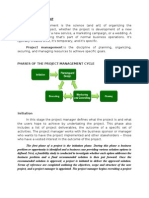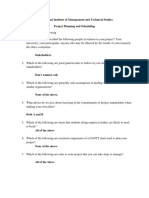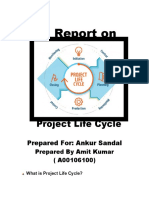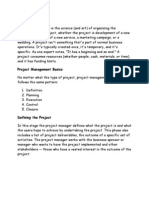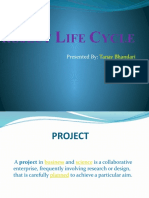0 ratings0% found this document useful (0 votes)
5 viewsIntroduction and Definitions
It talks about English language andany staff which helps the person
Uploaded by
chimbaleonard66Copyright
© © All Rights Reserved
Available Formats
Download as PPTX, PDF, TXT or read online on Scribd
0 ratings0% found this document useful (0 votes)
5 viewsIntroduction and Definitions
It talks about English language andany staff which helps the person
Uploaded by
chimbaleonard66Copyright
© © All Rights Reserved
Available Formats
Download as PPTX, PDF, TXT or read online on Scribd
You are on page 1/ 30
WHAT IS A PROJECT?
Several definitions exist for “project.”
In this context, a Project is defined as “A temporary
endeavour undertaken to achieve a particular aim”
(Hearkens, 2002).
A project is a temporary endeavour undertaken to create a
unique product, service, or Result (Project Management
Institute, 2004).
CHARACTERISTICS OF A PROJECT
Regardless of the definition used, nearly every project tends
to have the same characteristics.
1. A project is a response to a need or an opportunity or a
solution to a problem.
It’s a solution that promises a benefit—usually financial or
social benefits.
The fundamental purpose for most projects is to either
make money or save money or bring some kind of social
benefits to customers/beneficiaries.
That’s why projects have to be justified financially or
socially, as we’ll see later.
2. By definition, a project is temporary in nature; that means that it
has specific start and finish dates.
A project consists of a collection of well-defined tasks that
results into the creation of end product(s) or services
(deliverables).
This means there will be a preferred sequence of execution for
the project’s tasks (the schedule).
3. A project is a unique, one-time undertaking; it will never again be
done exactly the same way, by the same people, and within the
same environment.
NOTE, this suggests that a project manager will rarely have the
benefit of wealth of historical information when embarking on a
new project.
The project manager will have to launch a new project with
limited information or, worse yet, misinformation.
4. A project will always be associated with uncertainty.
This uncertainty represents risks—an ever-present threat to a
project manager’s ability to make definitive plans and predict
outcomes with high levels of confidence (e.g. delivery of
materials on time).
Project risk is an uncertain event or condition that, if it occurs,
has a positive or a negative effect on at least one project
management objective, such as time, cost, scope, or quality -
Triple Constraints.
All projects consume resources—for example; time, money,
materials, and labour.
Therefore, the primary goal for the project manager is to
serve as the overall steward - custodian of these resources - to
apply them as diligently and as effectively as possible.
Examples of projects: introducing a new product to the
marketplace, building an office block, constructing a road or
bridge and running a political campaign.
In contrast, operating a manufacturing facility, supervising a
work group, and running a business can not be classified as
projects - these activities are routine.
All projects consume resources—for example; time,
money, materials, and labour.
Therefore, the primary goal for the project manager is to
serve as the overall steward- custodian of these resources
- to apply them as diligently and as effectively as possible.
What Is Project Management?
The Project Management Institute defines project management as “. . .
the application of knowledge, skills, tools and techniques to project
activities to meet project requirements” (2000, p. 6).
To be able to apply the required skills, tools, and techniques, the project
manager need to have a significant amount of education and on-the-job
experience.
The project management process calls for the creation of a small
organizational structure (the project team), which is often a microcosm of
the larger organization (to be discussed later in the course).
Once the team has produced the desired outcome, the
process then calls for the decommissioning of the project
management structure.
Phases of a Project and Project Management
Projects typically have identifiable phases and each phase has a
unique set of challenges for the project manager.
There are four basic project phases that can be identified.
1. The Initiation Phase:
Under this project phase, the opportunity or problem is
identified.
An appropriate response to the opportunity or problem is then
determined and described (this is actually where the project
begins).
Under this phase, major deliverables (outputs) and the
participating work groups are identified.
It is under the initiation phase that the project team begins
to take shape.
Two main questions are asked under this phase;
can we do the project? (Issues of feasibility) and
should we do the project? (justification).
2. Planning Phase:
This is where the project solution is further developed in as
much detail as possible.
Interim deliverables(outputs) are identified, along with the
strategy for producing them.
Formulating this strategy begins with the definition of the
required elements of work and the optimum sequence for
executing them (the schedule).
Estimates are made regarding the amount of time and
materials needed to perform the work and when the work is
to be done.
At this stage, standards or quality of deliverables are discussed and
established.
The question of feasibility and justification surfaces again, as formal
approval to proceed with the project is ordinarily sought before
continuing.
3. Execution Phase,
Under this project phase, the prescribed work (tasks) is
performed under the supervision of the project manager.
Progress has to be continuously monitored (against the plan)
and appropriate adjustments are made and recorded as
variances from the original plan.
In most cases, approval has to be sought before making any
adjustments to the original implementation plan.
Throughout this phase, the project team has to remain
focused on meeting the objectives developed and agreed
upon at the outset of the project.
5. Final phase, or the Close-Out Phase,
Under this phase, the concern is making sure that the
project has satisfied or will satisfy the original need(s) that
were identified during the initiation phase.
Ideally, the project culminates with a smooth transition from
deliverable creation (the project) to deliverable utilization
(the post-project life cycle).
The customer accepts and uses the deliverables.
Throughout this phase, members of the project team are
gradually re-deployed and the project finally comes to an
end.
LECTURE TWO
LECTURE TWO
The Project Management Process: Step by Step
The project management process provides details in the areas
of mobilisation of materials, project definition, risk
management, and stakeholder management.
Step 1. Identify and frame the problem or opportunity.
In this phase, the fundamental need, problem or opportunity
is identified.
The need, problem or opportunity is then quantified with
respect to factors such as its size, shape, and extent.
This leads to the creation of a “Requirements Document”,
which articulates the need, problem or opportunity in much
more detail.
The real need, problem or opportunity must be completely
understood before attempting to define the best solution.
If this step is not handled properly, there is a very high
likelihood the project is going to fail.
The project is likely to fail if the requirements are not fully
defined, and impulse— rather than a rational process—is
used to determine the project solution.
Step 2. Identify and define the best project solution.
Here, the project manager has to decide the composition and
skills level of the project team.
The project team should assist in identifying and defining the
best project solution and all subsequent process steps.
This step begins by identifying all reasonable alternatives.
Techniques such as brainstorming or similar creativity
techniques may help the team to identify alternative solutions.
The project team then singles out the “best” solution or
response.
The solution or response becomes the actual project.
The project team then prepares Project Definition
Documents.
Project definition documents consist of a comprehensive
description of the preferred implementation plan, criteria for
project completion, and the definition of project success.
In many organizations, this step concludes with a formal
proposal to management and formal approval or
authorization to proceed is granted.
If the project is not approved, the process has to end at this
stage.
Step 3. Identify task and resource requirements.
Once the project solution is identified, and the project has
been approved, the next step, is to identify the task and the
resource requirements.
This is also referred to as project scope management.
Here, the project team has to identify all the work that needs
to be done (the tasks).
Preliminary resource commitments should be secured for all
the identified work.
Step 4. Prepare the control schedule and resource allocation
plan.
Creating the project schedule consists of several steps.
First, a network or logic diagram is prepared to display the
optimum sequencing of the tasks.
Next, the length of time required to complete each task (its
duration) is estimated.
Once the preferred sequence of tasks, the estimated task
durations, and an assumed project start date, are done, the
team can place tasks in “real time,”.
Step 5. Estimate project costs and prepare a project budget.
Here, the project manager coordinates the preparation of a
cost estimate for the project.
A variety of methods may be used to estimate cost, depending
upon the level of detail that is needed.
The budget is used to monitor and control cost expenditures
during project implementation.
Step 6. Analyse risk and establish stakeholder relationships.
Once the project team has identified the work, prepared the
schedule, and estimated the costs, the three fundamental
components of the planning process are complete.
There is need to identify and try to deal with anything that
might pose a threat to the successful completion of the
project.
This is called risk management.
In risk management, “high-threat” potential problems are
identified (e.g. delay in delivery of materials).
Action is taken on each high threat potential problem, either
to reduce the probability that the problem will occur or to
reduce the impact on the project if it does occur.
Risk analysis should be a continuous process: the project
team should be ever vigilant for threats to the project
success.
Identify all the project stakeholders and establish or solidify
relationships that will be maintained throughout the life of
the project.
Step 7. Maintain control and communicate as needed during
execution.
During project execution, the project team carries out the
identified tasks and progress information is reported
through regular team meetings.
The team uses this information to maintain control over
the direction of the project and takes corrective or
preventive action as needed.
The first course of action should always be to bring the
project back “on course,” to return to the original plan.
If that can-not happen, the team should record variations
from the original plan and record and publish modifications
to the plan.
Key stakeholders should be kept informed of project status
according to an agreed-upon frequency and format.
The plan should be updated and published on a regular basis.
Status reports should always emphasize the anticipated end
point in terms of cost, schedule, and quality of deliverables.
Step 8. Manage to an orderly close-out.
This step is often characterized by the development of a
punch list.
A punch list is a relatively small list of tasks that the project
team needs to complete in order to close out the project.
Finally, the team should conduct formal lessons learned
sessions, to examine what went well and what didn’t.
This process helps in knowledge generation and experience
which can be transferred back to the project organization so
as to help future project teams.
What Happens “After the Project” Is More Important than
the Project
As mentioned above, the deliverables that your project
produces will be accepted and used by a customer, client, or
user.
Accordingly, your knowledge of how, why, when, and where
your project’s deliverables will be used should form the basis
for making decisions throughout the entire life of the project.
This is called managing the project with a full life cycle
perspective.
This perspective recognizes the fact that many of the decisions
you make during the project will have far-reaching and
profound effects on the efficiency, productivity, utilization, and
profitability of the project deliverables after the project has
been completed.
You might also like
- 18-O-1480 - Exhibit 3 - DDA - Gulch (EZ Bonds) - Draw-Down Bond Purchase AgreementNo ratings yet18-O-1480 - Exhibit 3 - DDA - Gulch (EZ Bonds) - Draw-Down Bond Purchase Agreement32 pages
- Key Stages of Project Management/Project Life CycleNo ratings yetKey Stages of Project Management/Project Life Cycle14 pages
- ECU 401 L4 Project Lifecycle and Feasibility StudyNo ratings yetECU 401 L4 Project Lifecycle and Feasibility Study9 pages
- Chapter-2-Project MGT Lecture Note - (2024)No ratings yetChapter-2-Project MGT Lecture Note - (2024)12 pages
- Chapter 7: The Project Life Cycle (Phases) : PreviousnextNo ratings yetChapter 7: The Project Life Cycle (Phases) : Previousnext7 pages
- 1 Unit An Introduction To Project ManagementNo ratings yet1 Unit An Introduction To Project Management51 pages
- The 4 Phases of The Project Management Life CycleNo ratings yetThe 4 Phases of The Project Management Life Cycle9 pages
- CS042 Unit I Introduction and Software PlanningNo ratings yetCS042 Unit I Introduction and Software Planning25 pages
- m.com Cbcs -Pro. Plann. Manag. Proj. Life Cycle -By Dr. Kaynat TawarNo ratings yetm.com Cbcs -Pro. Plann. Manag. Proj. Life Cycle -By Dr. Kaynat Tawar10 pages
- Master The PRINCE2 Processes With Pictures100% (3)Master The PRINCE2 Processes With Pictures12 pages
- 18SW111 Operational Research: Mehran University of Engineering & Technology Jamshoro Ma'am Amirita DewaniNo ratings yet18SW111 Operational Research: Mehran University of Engineering & Technology Jamshoro Ma'am Amirita Dewani24 pages
- Project Planning, Management, Monitoring, & EvaluationNo ratings yetProject Planning, Management, Monitoring, & Evaluation9 pages
- PM Case Study Overview Developing and Managing A WbsNo ratings yetPM Case Study Overview Developing and Managing A Wbs6 pages
- Black and White Vintage Newspaper Motivational Quote Poster (9 x 12 in)No ratings yetBlack and White Vintage Newspaper Motivational Quote Poster (9 x 12 in)2 pages
- Attack Proof The Ultimate Guide to Personal Protection 2nd ed Edition John Perkins - The full ebook version is available, download now to explore100% (2)Attack Proof The Ultimate Guide to Personal Protection 2nd ed Edition John Perkins - The full ebook version is available, download now to explore71 pages
- Budget Motivation Speech For Prison ServicesNo ratings yetBudget Motivation Speech For Prison Services9 pages
- Microsoft Office Specialist World Championship Is A Global Competition That AssessesNo ratings yetMicrosoft Office Specialist World Championship Is A Global Competition That Assesses2 pages
- International Relations and Diplomacy ISNo ratings yetInternational Relations and Diplomacy IS66 pages
- Io Games Unblocked - Cookie Clicker - Io 4No ratings yetIo Games Unblocked - Cookie Clicker - Io 41 page
- Date Financial Assets Held For Trading: ILLUSTRATION 1: Initial MeasurementNo ratings yetDate Financial Assets Held For Trading: ILLUSTRATION 1: Initial Measurement2 pages
- Republic of The Philippines: Barangay LibertadNo ratings yetRepublic of The Philippines: Barangay Libertad3 pages
- All India Prelims Test Series - 2017: Indian Polity + GeographyNo ratings yetAll India Prelims Test Series - 2017: Indian Polity + Geography11 pages
- B1 Documented Information For Defined Roles, Responsibilities and Authorities..No ratings yetB1 Documented Information For Defined Roles, Responsibilities and Authorities..3 pages
- Form - A5 - Student - REVISED PS 09012018 PDFNo ratings yetForm - A5 - Student - REVISED PS 09012018 PDF3 pages
- 18-O-1480 - Exhibit 3 - DDA - Gulch (EZ Bonds) - Draw-Down Bond Purchase Agreement18-O-1480 - Exhibit 3 - DDA - Gulch (EZ Bonds) - Draw-Down Bond Purchase Agreement
- Key Stages of Project Management/Project Life CycleKey Stages of Project Management/Project Life Cycle
- ECU 401 L4 Project Lifecycle and Feasibility StudyECU 401 L4 Project Lifecycle and Feasibility Study
- Chapter 7: The Project Life Cycle (Phases) : PreviousnextChapter 7: The Project Life Cycle (Phases) : Previousnext
- m.com Cbcs -Pro. Plann. Manag. Proj. Life Cycle -By Dr. Kaynat Tawarm.com Cbcs -Pro. Plann. Manag. Proj. Life Cycle -By Dr. Kaynat Tawar
- 18SW111 Operational Research: Mehran University of Engineering & Technology Jamshoro Ma'am Amirita Dewani18SW111 Operational Research: Mehran University of Engineering & Technology Jamshoro Ma'am Amirita Dewani
- Project Planning, Management, Monitoring, & EvaluationProject Planning, Management, Monitoring, & Evaluation
- PM Case Study Overview Developing and Managing A WbsPM Case Study Overview Developing and Managing A Wbs
- Managing Project Teams: Shortcuts to successFrom EverandManaging Project Teams: Shortcuts to success
- Black and White Vintage Newspaper Motivational Quote Poster (9 x 12 in)Black and White Vintage Newspaper Motivational Quote Poster (9 x 12 in)
- Attack Proof The Ultimate Guide to Personal Protection 2nd ed Edition John Perkins - The full ebook version is available, download now to exploreAttack Proof The Ultimate Guide to Personal Protection 2nd ed Edition John Perkins - The full ebook version is available, download now to explore
- Microsoft Office Specialist World Championship Is A Global Competition That AssessesMicrosoft Office Specialist World Championship Is A Global Competition That Assesses
- Date Financial Assets Held For Trading: ILLUSTRATION 1: Initial MeasurementDate Financial Assets Held For Trading: ILLUSTRATION 1: Initial Measurement
- All India Prelims Test Series - 2017: Indian Polity + GeographyAll India Prelims Test Series - 2017: Indian Polity + Geography
- B1 Documented Information For Defined Roles, Responsibilities and Authorities..B1 Documented Information For Defined Roles, Responsibilities and Authorities..



